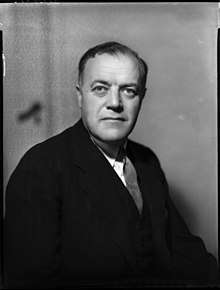Richard Stokes
Richard Rapier Stokes, MC (27 January 1897 – 3 August 1957) was a British soldier and Labour politician who served briefly as Lord Privy Seal in 1951.
Richard Stokes MC MP | |
|---|---|
 | |
| Minister of Materials | |
| In office 6 July 1951 – 26 October 1951 | |
| Leader | Clement Attlee |
| Preceded by | Office established |
| Succeeded by | Viscount Swinton |
| Lord Keeper of the Privy Seal | |
| In office 26 April 1951 – 26 October 1951 | |
| Leader | Clement Attlee |
| Preceded by | Ernest Bevin |
| Succeeded by | The Marquess of Salisbury |
| Minister of Works | |
| In office 28 February 1950 – 26 April 1951 | |
| Leader | Clement Attlee |
| Preceded by | Charles Key |
| Succeeded by | George Brown |
| Member of Parliament for Ipswich | |
| In office 16 February 1938 – 3 August 1957 | |
| Preceded by | John Ganzoni |
| Succeeded by | Dingle Foot |
| Personal details | |
| Born | Richard Rapier Stokes 27 January 1897 |
| Died | 3 August 1957 (aged 60) London |
| Cause of death | Cardiac arrest |
| Nationality | British |
| Political party | Labour |
| Parents | Philip Folliot Stokes Mary Fenwick Rapier |
| Alma mater | Trinity College, Cambridge |
The second son of Philip Folliott Stokes and his wife Mary Fenwick Rapier, the only surviving child of Richard Christopher Rapier (1836-1897) of Ransomes & Rapier,[1] Richard Stokes was educated at Downside School, the Royal Military Academy, Woolwich and Trinity College, Cambridge. He served in the Royal Artillery during World War I, winning the Military Cross and bar and the Croix de Guerre. His uncle Sir Wilfred Stokes, chairman and managing director of the engineering firm Ransomes & Rapier invented the Stokes Mortar in World War I. His uncle Leonard Stokes was an architect who designed the new buildings at Downside School (built 1912, when Richard was at Downside). Richard Stokes was chairman (1939) and supporter of the School of Economic Science.[2]
On going down from Cambridge he joined his family's business, Ransomes & Rapier, and was made managing director at the age of 30. When rearmament was proposed by the National Government Stokes offered to charge the nation cost price for all his firm's rearmament work. It was rejected by the National Government and shortly afterwards he joined the Labour Party. Though he held office under Labour governments he was said to have remained a backbencher at heart.[1]
Stokes won the Ipswich seat in a 1938 by-election, which he kept in the 1945, 1950, 1951 and 1955 elections. He was known for his independence in parliament, including, with Bishop George Bell and fellow Labour Member of Parliament (MP) Alfred Salter, opposing area strategic bombing during World War II. Stokes was also a prominent critic of the inadequacy of Allied tank design. Prior to the war, he co-wrote a paper (with Andrew MacLaren and George Lansbury) analysing the economic forces menacing peace in Europe.[3] After the RAF's bombing of Dresden on the night of 13 February and the early hours of 14 February 1945, his questions in the House about the act[4] were in part responsible for the reappraisal of the Government's bombing policy in the last month of the war in Europe. He raised other issues after the war relating to Yalta and the forced repatriation of Yugoslavs, and the treatment of Dr George Chatterton-Hill in Germany.
Following the 1945 general election, Labour were returned to power. Stokes devoted much of his energy to the Friends of Ireland group, of which he was treasurer.[5] He was appointed Lord Privy Seal and the new position of Minister of Materials in April 1951, succeeding Ernest Bevin but served only a few months before Labour lost the 1951 general election. He aimed to show that the proposed armaments programme could be carried out, contrary to Aneurin Bevan and Harold Wilson (who had resigned over this and other issues).
Stokes died at home in London of a heart attack according to his death notice, although he had been in a road accident on 23 July when his car overturned during a thunderstorm on the flooded London road at Stanway near Colchester.[6]
References
- Obituary. Mr. R. R. Stokes. The Times, Monday, Aug 05, 1957; pg. 9; Issue 53911
- Brian Hodgkinson (2010). In Search of Truth. Shepheard-Walwyn (Publishers). ISBN 978-0-85683-276-5. External link in
|title=(help) pages 10, 20 - John Stewart (2009). Standing for Justice. Shepheard-Walwyn. ISBN 978-0-85683-194-2. External link in
|title=(help) page 153 - http://hansard.millbanksystems.com/commons/1945/mar/06/air-estimates-1945#S5CV0408P0_19450306_HOC_313
- Bob Purdie, "The Friends of Ireland", in: Tom Gallagher, Contemporary Irish Studies, pp.81-94
- The Times, London, 1957: 23 July p. 12; 5 August pp. 1,9
- The Times House of Commons 1945. 1945.
- The Times House of Commons 1950. 1950.
- The Times House of Commons 1955. 1955.
External links
- Hansard 1803–2005: contributions in Parliament by Richard Stokes
- Profile
- Newspaper clippings about Richard Stokes in the 20th Century Press Archives of the ZBW
| Parliament of the United Kingdom | ||
|---|---|---|
| Preceded by Sir John Ganzoni |
Member of Parliament for Ipswich 1938–1957 |
Succeeded by Dingle Foot |
| Political offices | ||
| Preceded by Charles Key |
Minister of Works 1950–1951 |
Succeeded by George Brown |
| Preceded by Ernest Bevin |
Lord Privy Seal 1951 |
Succeeded by The Marquess of Salisbury |